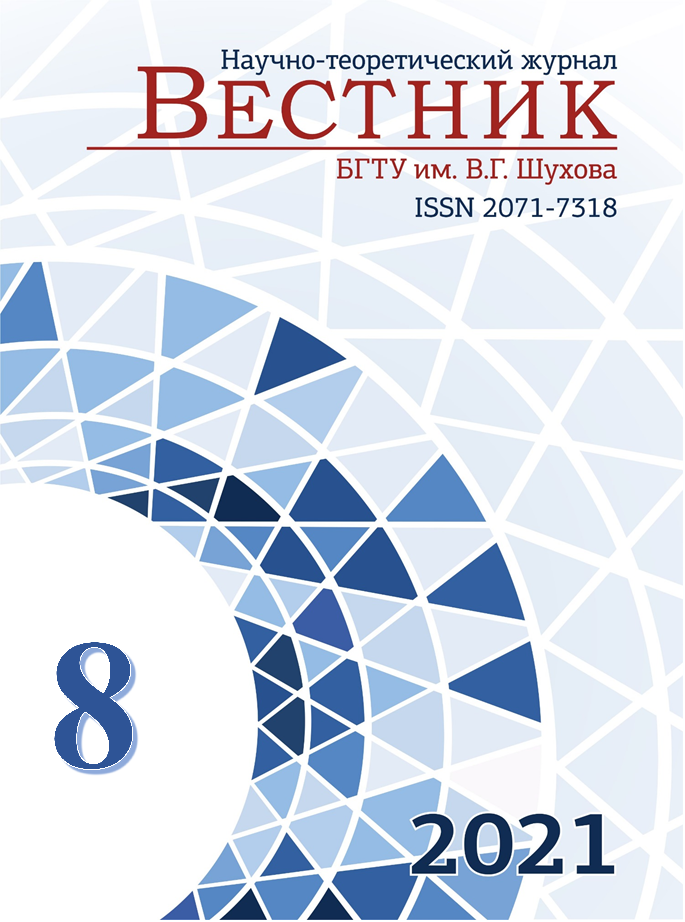Belgorod, Russian Federation
Russian Federation
Belgorod, Belgorod, Russian Federation
Belgorod, Belgorod, Russian Federation
Belgorod, Belgorod, Russian Federation
UDC 69
The main thermal processes occurring during the operation of a gas burner device for household use are considered. One of the important functions performed by the gas burner device is the preparation of fuel for subsequent combustion. The efficiency and quality of the combustion process directly depends on the temperature of the gas-air mixture. Since an increase in the temperature of the mixture contributes to the intensification of the combustion process, when designing gas burner devices, it is useful to determine the temperature of the gas-air mixture inside the burner body. We have proposed a solution that makes it possible to increase the efficiency of the gas burner device by intensifying the preheating from the thermal divider to the gas-air mixture inside the body of the gas burner. It has been established that the placement of the thermal divider in the central part on the inner side of the cover allows one to reduce the stagnant zone area when the flow of the gas-air mixture moves, and the conical shape of the thermal divider provides minimal resistance to the movement of the gas-air mixture flow inside the gas burner, in addition, the side surface of the thermal divider additionally increases the area heat transfer. An expression is obtained for calculating the average temperature of the gas-air mixture at the outlet from the firing holes of the gas burner.
preheating, gas-air mixture, thermal divider, heat exchange, combustion, gas burner
1. Statistical compilation. FEK of Russia - 2019. Analytical center under the government of the Russian Federation [Statisticheskij sbornik. TEK Rossii - 2019. Analiticheskij centr pri Pravitel'stve Rossijskoj Federacii]. URL: https://www.ac.gov.ru/publications/topics/topic/13700 (date of treatment: 18.05.2021) (rus)
2. Gazprom public joint stock company annual report for 2019 [Godovoj otchet PAO «Gazprom» za 2019 g.]. URL: https://www.gazprom.ru/investors/disclosure/reports/2019/ (date of treatment: 18.05.2021) (rus)
3. Bantu A.A, Nuwagaba G, Kizza S., Turinayo Y.K. Design of an Improved Cooking Stove Using High Density Heated Rocks and Heat Retaining Techniques. Journal of Renewable Energy. 2018. Pp. 1-9. DOI.org/10.1155/2018/9620103
4. Decker T.J. Modeling tool for household biogas burner flame port design, A TJ Decker-CSU Theses and Dissertations. Colorado State University. Fort Collins, Colorado, 2017. 95 p.
5. Turns S.R. An Introduction to Combustion: Concepts and Applications, 3rd Edition. WBC McGraw-Hill. New York, 2012. 754 p.
6. Le Corre O., Loubar K. Natural Gas: Physical Properties and Combustion Features. Engineering & Technology, Physical Sciences. 2010. Pp. 39-70
7. Hull S. et al Guidebook to Gas Interchangeability and Gas Quality. Published by BP in association with the IGU. Brussels. 2011. 156 p.
8. Jugjai S., Rungsimuntuchart N. High efficiency heat-recirculating domestic gas burners Experimental Thermal and Fluid Science. 2002. Vol. 26. No. 5. Pp. 581-592 DOIhttps://doi.org/10.1016/S0894-1777(02)00164-4
9. Aroonjarattham P. The Parametric Studied of High Pressure Gas Burner Affect Thermal Efficiency Engineering journal. 2016. Vol. 20. No. 3. Pp. 33-48 DOIhttps://doi.org/10.4186/ej.2016.20.3.33
10. Khan M., Saxena A. Performance Of LPG Cooking Stove Using Different Design Of Burner Heads International Journal of Engineering Research & Technology. 2013. Vol. 2. No. 7. Pp. 656-659.
11. Dahiya D., Singh L.R., Bhatia P. Improvement of the Domestic LPG Cooking Stoves: A Review. Indian Journal of Science and Technology. 2016. Vol. 9. No. S1. Pp. 1-8 DOI:https://doi.org/10.17485/ijst/2016/v9iS1/105856
12. Huda Z. Metallurgy for Physicists and Engineers. Fundamentals, Applications, and Calculations. Engineering & Technology, Physical Sciences. London, 2020. 360 p.
13. Yang Y.T., Tsai S.Y. Numerical study of transient conjugate heat transfer of a turbulent impinging jet. International journal of heat and mass transfer. 2007. Vol. 50. No. 5-6. Pp. 799-807 DOI.org/10.1016/j.ijheatmasstransfer.2006.08.022
14. Xin Liu, Gabour L.A., Lienhard V.J.H. Stagnation-Point Heat Transfer During Impingement of Laminar Liquid Jets. Analysis Including Surface Tension J. Heat Transfer. 1993. Vol. 115. Pp. 99-105 DOIhttps://doi.org/10.1115/1.2910677
15. Nakoryakov V.E., Pokusaev B.G., Troyan E.N. Impingement of an axisymmetric liquid jet on a barrier Int. J. Heat Mass Transfer. 1978. Vol. 21. No. 9. Pp. 1175-1184 DOI.org/10.1016/0017-9310(78)90136-9
16. Tenenev V.A, Gubert A.V., Mihajlov Yu.O., Korepanov M.A. Research of processes in gas burners for household stoves [Issledovanie processov v gazovyh gorelkah dlya bytovyh plit] Udmurtskij federal'nyj issledovatel'skij centr UrO RAN «Himicheskaya fizika i mezoskopiya» Izhevsk. 2010. Vol. 12. No. 1. Pp. 45-53 (rus)
17. Suslov D.Y., Ramazanov R.S., Temnikov D.O., Lobanov I.V. Development and research of low pressure injection burner for biogas combustion. IOP Conf. Series: Materials Science and Engineering 2019 (Belorgod: Institute of Physics Publishing) Vol. 552. Pp. 012031 DOI.org/10.1088/1757-899x/552/1/012031
18. Suslov D.Y., Ramazanov R.S. Simulation of biogas combustion in an injection burner with a heat divider [Modelirovanie szhiganiya biogaza v inzhekcionnoj gorelke s teplovym rassekatelem] Bulletin of BSTU named after V.G. Shukhov. 2020. No. 4. Pp. 40-47 (rus) DOI:https://doi.org/10.34031/2071-7318-2020-5-4-40-47
19. Yunus A. Heat transfer. A Practical Approach. Second Edition. WBC McGraw-Hill. New York, 1998. 1006 p.
20. John H., Lienhard I.V., John H., Lienhard V. A heat transfer textbook, 5th edition. Phlogiston Press. Cambridge, 2019. 784 p.
21. Kelleher M.D. et al Experimental Heat Transfer, Fluid Mechanics and Thermodynamics. Elsevier. Amsterdam, 1993. 1864 p.
22. Viskanta R. Heat Transfer to Impinging Isothermal Gas and Flame Jets. Experimental Thermal and Fluid Science. 1993. Vol. 6. No. 2. Pp. 111-134. DOI.org/10.1016/0894-1777(93)90022-B
23. Kuznetsov V.A., Trubaev P.A. Convective heat transfer in the near-wall turbulent gas stratum IOP Conf. Series: Materials Science and Engineering 2019 (Belorgod: Institute of Physics Publishing). Vol. 552. Pp. 012005. DOIhttps://doi.org/10.1088/1757-899X/552/1/012005
24. Geers L.F.G., Tummers M.J., Bueninck T.J., Hanjalic K. Heat transfer correlation for hexagonal and in-line arrays of impinging jets International journal of heat and mass transfer. 2008. Vol. 51. No. 21-22. Pp. 5389-5399. DOI.org/10.1016/j.ijheatmasstransfer.2008.01.035
25. Gardiner W.C.Jr. (Ed.) Gas-Phase Combustion Chemistry 2nd Edition. Springer. Dordrecht, 1999. 556 p.
26. Raju K.S.N. Fluid mechanics, heat transfer, and mass transfer. Chemical engineering practice. John Wiley & Sons Limited. New York, 2011. 750 p.
27. Penumadu P.S., Rao A.G. Numerical investigations of heat transfer and pressure drop characteristics in multiple jet impingement system. Applied Thermal Engineering. 2017. Vol. 110. Pp. 1511-1524. DOIhttps://doi.org/10.1016/j.applthermaleng.2016.09.057














